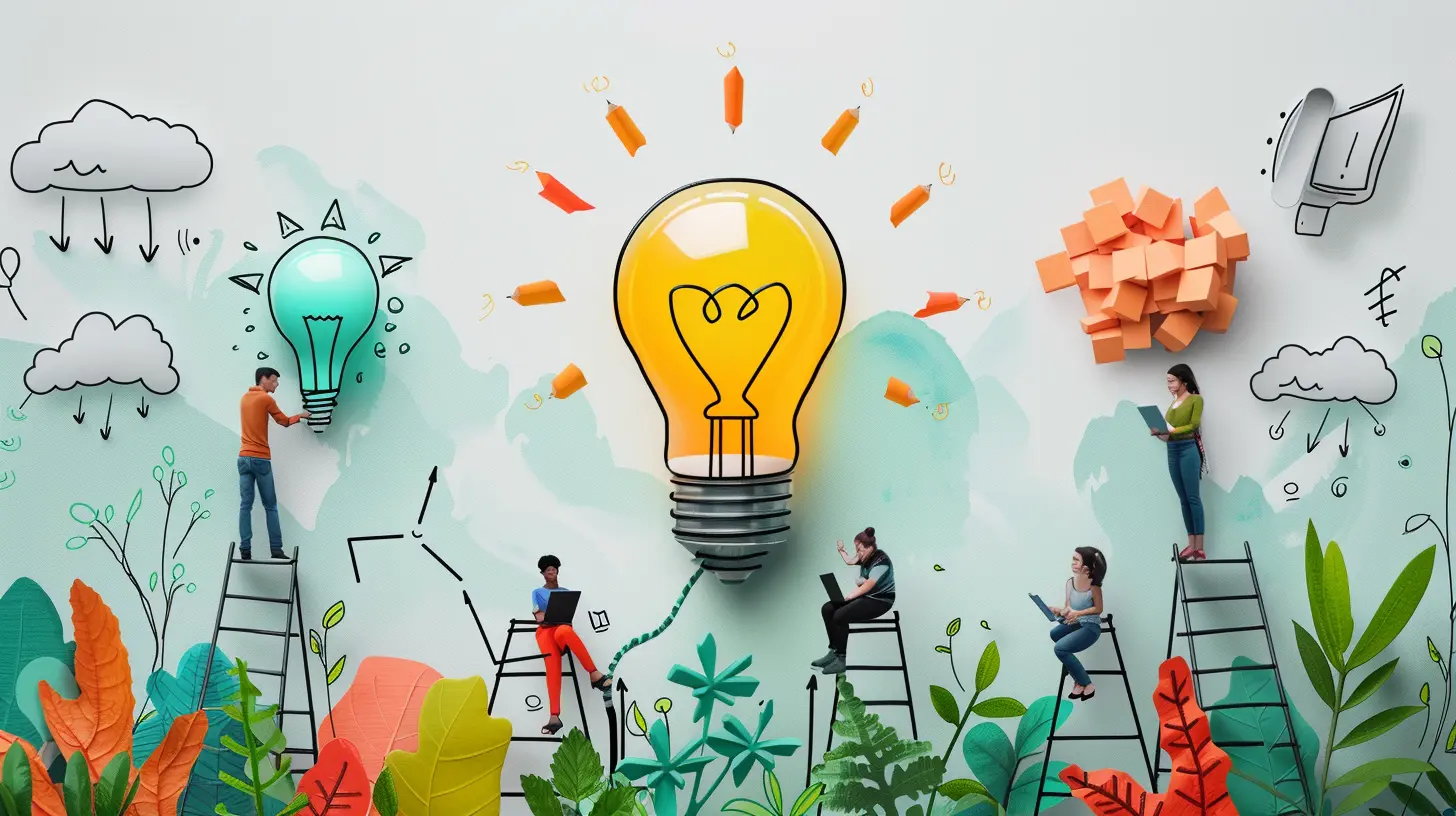Empowering Students to Tackle Real-World Problems
15 November 2025
Let’s be honest—education has come a long way from memorizing facts and scribbling notes in the back of a dusty textbook. Today, it’s all about engagement, innovation, and preparing students for the wild, wonderful, unpredictable ride that is the real world. So, how do we get students ready for life outside the classroom? Easy—we empower them to solve real-world problems.
Yep, we’re talking about turning curious kids into confident changemakers. Think of it like giving them a toolbox stocked with creativity, critical thinking, and a whole lot of "I can do this!" energy. Ready to dive into how we do that? Let’s roll!

Why Empower Students in the First Place?
Let’s rewind a bit. Why is student empowerment such a big deal?Well, imagine trying to teach someone how to swim without letting them touch the water. Sounds ridiculous, right? It’s the same with students. If we want them to be problem-solvers, leaders, and lifelong learners, they have to get their hands dirty—figuratively (and sometimes literally).
When students are empowered:
- They become active, not passive, learners.
- They develop confidence and independence.
- They approach challenges with curiosity instead of fear.
It’s not just about getting good grades. It’s about giving them the tools to make an impact in their communities—and the world.

Real-World Problems: The Best (and Messiest) Teachers
Let’s face it, worksheets are fine. But real-world problems? That’s where the magic happens.Things like:
- Climate change
- Inequality
- Community health
- Access to education
- Cybersecurity
- Food waste
These aren’t just headlines—they’re invitations for students to think, create, debate, and innovate.
And the best part? These problems don’t come with an answer key. That means students get to explore solutions, fail, try again, and ultimately come up with something original. It’s like giving them a giant puzzle and saying, “Go on, solve it your way.”

Project-Based Learning: A Game Changer
Alright, let’s talk tools. One of the most powerful ways to empower students is through Project-Based Learning (PBL).What’s that, you ask? Picture this: students work on a project over several weeks, tackling a real-world question, problem, or challenge. They research, collaborate, and present solutions. Basically, they act like mini-scientists, engineers, or entrepreneurs.
Some examples:
- Designing affordable housing models using sustainable materials.
- Creating campaigns to spread awareness about mental health in schools.
- Building apps to help local businesses connect with more customers.
PBL doesn’t just spice things up—it gives context to what they’re learning. Suddenly, math isn’t just numbers; it’s budgeting for a real event. English isn’t about essays; it’s about writing persuasive letters to city council.

Let Them Take the Wheel
You know what kids love? Ownership. Nothing makes a student light up like being told, “This is your project—run with it.”Giving students agency doesn’t mean tossing them into chaos. It means giving them choices and trusting them enough to lead the way. Whether it’s picking the topic of their project, choosing group partners, or deciding how to present their findings, ownership breeds engagement.
When students feel like their voice matters, they show up. Enthusiastically.
Technology: The Not-So-Secret Ingredient
Let’s be real—we live in a digital world, and students are digital natives. So why not use that to their advantage?Here’s how tech can empower students:
- Virtual simulations help them practice real-world scenarios.
- Online collaboration tools make teamwork easier (and more fun).
- Access to global data allows for deeper, richer research.
- Platforms like YouTube and Canva encourage creative presentations.
They’re already scrolling, streaming, and swiping like pros—why not channel that into problem-solving power?
Collaboration Over Competition
Say it with me: Collaboration is key.Empowering students isn’t about creating the next Steve Jobs (though that’d be cool). It’s about teaching them how to work well with others. Because let’s be honest—nothing big gets solved solo.
Think:
- Group brainstorms
- Peer feedback sessions
- Interdisciplinary partnerships (hello, science + art!)
When students learn to listen, share ideas, and problem-solve together, they get a taste of the real-world team dynamic. And that’s gold.
Encouraging a Growth Mindset
If there’s one thing all real-world problem-solvers have in common, it’s this: they don’t give up easily.A growth mindset teaches students that mistakes aren’t failures—they’re stepping stones. That improvement is always possible. That learning doesn’t stop when the bell rings.
So how do we nurture this mindset?
- Celebrate effort, not just results.
- Encourage reflection after challenges.
- Share stories of real people who failed before they succeeded.
Remember, even superheroes had to learn how to fly.
Real People, Real Problems, Real Inspiration
Bringing in experts from the field—whether it’s a local entrepreneur, civil engineer, or environmental activist—can light a fire in students.Guest speakers, virtual field trips, and mentorships connect classroom learning to real-world impact. Suddenly, students aren’t just learning about change—they’re learning from changemakers.
And that’s beyond inspiring.
Equity and Inclusion: Everyone Gets a Seat at the Table
Empowerment isn’t just for the loudest student or the top of the class. Every student deserves the chance to engage with real-world issues, regardless of background, ability, or academic level.Here’s how we keep things inclusive:
- Use culturally relevant problems and examples.
- Make sure every voice is heard in group work.
- Provide different ways to show learning—videos, posters, speeches, you name it.
Diversity of thought leads to better solutions. Always.
Role of Educators: Be the Guide, Not the Guru
Teachers, we see you. You’ve got a million things on your plate. But guess what? You don’t have to have all the answers.In this model, your role shifts from “lecturer” to “facilitator.” You’re the coach on the sidelines—guiding, cheering, nudging. Let students drive the learning while you provide support, context, and feedback.
And hey, learning alongside your students? That’s pretty empowering too.
Parents Matter More Than You Think
Parents and guardians are the secret sauce. When they’re informed and involved, students feel supported not just at school—but at home too.Tips to get them on board:
- Share project goals and progress.
- Invite them to presentations or exhibitions.
- Encourage home discussions around the real-world issues being tackled.
It’s a team effort, and parents are MVPs.
The Ripple Effect: Long-Term Benefits
Empowering students today shapes the world tomorrow. No exaggeration.Students who’ve learned to tackle complex problems:
- Become more adaptable in their careers.
- Are more engaged citizens.
- Lead with empathy and purpose.
It’s like planting seeds—you may not see the full bloom right away, but the roots? They’re strong and deep.
Small Steps to Big Impact
Now, this might sound like a LOT. But don’t worry—it doesn’t take a complete curriculum overhaul to start empowering students.Here are some bite-sized ways to begin:
- Kick off a weekly “real-world problem” discussion.
- Add a reflection journal to existing projects.
- Partner with a local organization for a class initiative.
- Let students co-create part of the lesson plan.
Remember: every journey starts with a single step (even if that step looks like a wobbly freshman presentation on saving sea turtles).
Final Thoughts: Let’s Raise Some World-Changers
We live in a world that desperately needs fresh ideas, bold voices, and compassionate doers. The good news? Classrooms are full of them—if we give them the tools, the trust, and the time.Empowering students to tackle real-world problems isn’t about having all the answers. It’s about creating space for questions, creativity, collaboration, and growth.
Let’s raise a generation that doesn’t just learn about the world—but leaves it better than they found it.
Because honestly? The future is in pretty great hands.
all images in this post were generated using AI tools
Category:
Problem SolvingAuthor:

Anita Harmon

